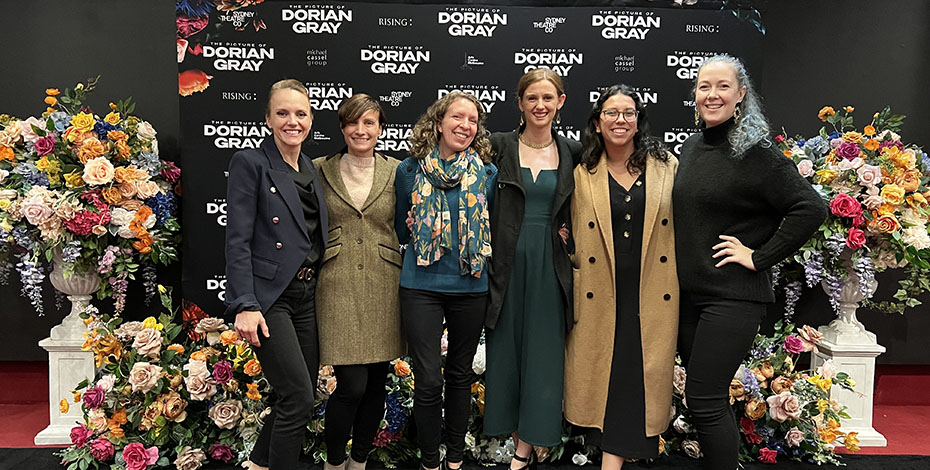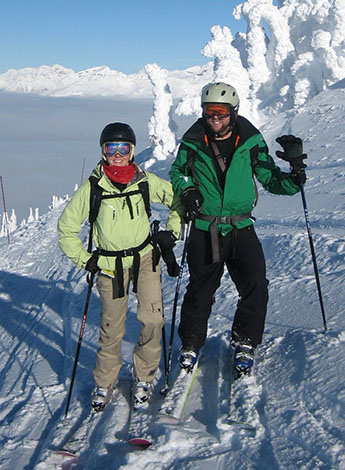
Giving voice to a love of arts and science

For Annie Strauch APAM MACP, successful outcomes in her work are not about what you see, but what you hear.
As one of Australia’s leading vocal physiotherapists, Annie Strauch helps people with vocal issues, providing treatment so they can improve the way they use their voice and can connect their voice to their body and breath.
Annie’s list of patients ranges from the everyday person wanting to play sport or speak and read out loud to professional performers and athletes.
They could be seeking treatment for voice quality issues, experiencing an increased effort and/or pain with vocalisation or perhaps tongue tension or throat pain of a muscular origin.
‘We give people with musculoskeletal voice issues strategies to help them to retrain and to understand how they can make changes themselves and not always be reliant on seeking treatment. The goal is that they become independent,’ Annie says.
The APA Sports and Exercise Physiotherapist and APA Musculoskeletal Physiotherapist describes vocal physiotherapy as encompassing treatment of the myofascial, muscular and cartilaginous structures of the larynx and the surrounding peri-laryngeal region to produce efficient vocal fold vibration and voice production.
It helps people break their maladaptive voice habits and retrain their voice and body.

The remount of Harry Potter and the Cursed Child on opening night. Annie's theatre work includes physical conditioning programs, often in pre-production.
‘We’re using this form of treatment as a neuromuscular circuit breaker to alleviate discomfort and achieve the most efficient voice production possible,’ she says of the manual therapy or ‘hands-on’ treatment.
‘This lays the foundation for neuromuscular retraining of the musculoskeletal components affecting the voice.’
Assessment and treatment may include a review of the posture of the head and neck, the lumbopelvic region, the cervical spine and the temporomandibular joint along with scapular kinematics and breathing patterns.
‘In simplistic terms, our voice is produced not only by the vibration of the vocal folds, but also by the complex coordination of breath, posture, muscle tone and recruitment.’
This is called the ‘power–source–filter’ model and, in conjunction with the anatomy of the larynx, it displays the interrelationship with and dependency of the voice on the rest of the body.
'Vocal physiotherapy not only assesses and treats the laryngeal region but also assesses voice production holistically through the whole body.
Annie opened her Melbourne clinic, Performance Medicine, in 2010 (there is also a clinic in Sydney) after developing her passion for performance physiotherapy in London’s West End in the mid-2000s.
In what was then considered the breakthrough approach of using physiotherapy for vocal support, the UK clinic where Annie worked collaborated with ear, nose and throat specialists, speech pathologists, doctors, surgeons and vocal coaches to support performing artists with their singing.
‘In the theatre, a vocal physiotherapist will consider the biomechanics of how staging, props and costumes—such as a heavy cape or a tight dress and corset—can create load through the body that can become uncomfortable and increase the load on the musculoskeletal components producing the voice.
'Additionally, how will the requirements needed to produce an actor’s character affect the posture of their larynx, head and neck and therefore how they produce their voice?’
Annie undertook further study and training to bring vocal physiotherapy to Australia.
In the years since, she has obtained both a master’s in sports and exercise physiotherapy and a master’s in musculoskeletal physiotherapy to bring science and sports science to the arts.
Today, Annie and her team of 30 are the resident physiotherapists for the Melbourne Theatre Company and for national production houses and dance and circus schools.
Her patient list includes some of the world’s who’s who of opera singers, pop singers and musicians, yet Annie is equally committed to helping any person optimise their laryngeal position and their breathing mechanics ‘so they can produce their voice for everyday things like speaking on the phone or reading to their kids’.
‘Physiotherapists have so much knowledge about palpation and interpreting tissues and understanding biomechanics, so there is a real crossover in how we can work with speech pathologists and other allied health professionals to get positive outcomes. This is what I am passionate about.’
Annie grew up in Shepparton, Victoria and describes her early years as idyllic. Between home and school, in addition to plenty of talk about sport, musical interests and the arts, there was a lot of ‘doing’.
‘I was always very active and loved my sport. In the early years, it was ballet, netball and aerobics. It was the 90s—back in the day when you practised your facial expression while doing jumping jacks and push-ups and practising your breathing,’ she says.

Annie enjoyed European and US skiing during her travels in 2006.
There was also the learning of new languages, singing and piano lessons. In the latter years of high school, something had to give.
‘A choir teacher actually told me I had to pick between sport and music... and so I did. It was sport. Ironically, the two things I was told to choose between as a teenager—sports science and the arts—I am now bringing together. Those two passions drive me.’
When the time came to choose a career path, she thought physiotherapy would enable her to combine travel with work.
‘It wasn’t until I was in London working that I really found my niche as a performing arts and vocal physiotherapist. Interestingly, I didn’t get into physio in the first rounds. I had to wait.
'I say to people, “Look, if you really want it, you’ll work it out. And if it doesn’t work out, it’s not the end”.’
Annie undertook study at La Trobe University’s Bundoora campus. Anatomy and cardiothoracic physiotherapy were, respectively, her ‘favourite and best subjects’.
An honours year focused on cardiothoracic work led to 18 months at the Austin Hospital, which also included general medical and acute spinal work.
‘Years later, in London, I was starting to bring together what I learned in those early days—how your breath, your voice and your ability to communicate, the mechanics of it, actually connect together.’
Interestingly, the ‘sliding door moment’ where she was introduced to voice physiotherapy almost never happened.
‘I spent six months travelling the globe and I really wanted to do something different when I got to the UK. However, an old uni tutor from La Trobe, who was also in London, suggested that I apply for this physio job and I got it.’
The clinic was called Physio Ed Medical and it focused on West End performers.
‘Voice physio and music theatre was their jam. Performers would come to the clinic for all their musculoskeletal and sporting injuries and for voice physio. I learned a lot and quickly realised that this is what I wanted to do.’
That job was one of three Annie applied for.
‘I still took the other two,’ she says. ‘I was mostly working afternoons and nights for the West End job, so I had the time and the desire to experience something else.’
The ‘something else’ included being the physiotherapist at the very first Virgin Active gym in London and doing postoperative anterior cruciate ligament treatment at a private clinic.
‘Virgin had just launched its first gym in 2005 and I worked at that gym, which was their flagship. I did sports physio but it was quite lonely because I was the sole practitioner working in a room.
'I wanted to work in a team; I wanted to collaborate with other people. Over time, I was able to go full-time with the West End job.’
Over the next three years, she experienced a career-defining role and learned important lessons about maintaining patient confidentiality and being conscious of her own voice.
‘Interestingly, people loved the Australian accent and felt comfortable knowing that I was Australian. We have a good reputation that includes being down-to-earth, relatable and respectful.
'But while I was seeing people who were the lords and ladies of London, I had to learn how to articulate properly because no one could understand my accent.
‘I had to learn how to speak in a different way, which is quite interesting when I reflect on the development work I did with my own voice and what I am doing now.
‘One of the biggest things I learned from that job, from a patient perspective, is that people want to come to therapy and just be themselves.
'They don’t want to be splashed onto the front page of a UK paper. The UK media was hungry to know who was seeking treatment.
'One day, they were outside the clinic taking photos of someone who was coming in. The clinic manager went ballistic, but it turned out to be the singer’s agent who had set off the media.’
She remains tight-lipped about the famous faces she supports.
‘What happens in the consultation room stays in the consultation room. Vocal physiotherapists work in an intimate, vulnerable space. We’re dealing with an area of people’s bodies that people are not used to having therapy on.
'We use our voice to communicate and to express our feelings. So people don’t necessarily always want other people to know about them having treatment.
‘But I do like seeing some of my patients as my favourite performers on stage. I’m not a speech pathologist but I can be a little critical and recognise when they are struggling with their voice.’
Success for a patient, she says, comes from a collaborative approach between a physiotherapist and a referring ear, nose and throat specialist or speech pathologist, combined with regularly ‘thinking outside the box’.
‘Vocal physiotherapy has taught me that we need to look at research that may not necessarily be specifically about physiotherapy, to collaborate with other practitioners and, as a therapist, to really understand what you’re doing.’
Annie’s ongoing professional development includes regular attendance at ear, nose and throat conferences, undertaking temporomandibular joint courses and actively engaging with the Laryngology Society of Australasia.
Since 2013, she has developed vocal physiotherapy training in Australia.
‘Learning is a lifelong journey. My parents were always curious about the world and about people. I think they instilled that in me—to investigate, to ask questions and to be open to what is possible.
'I like to think I am instilling that in my own three daughters and in my business.
‘I started as a sole practitioner and I would like to think that I have created a space where team members can bring sport, science and the arts together. Working in a team has been a driver for all the opportunities I sought.
'My work with clients is not only about what you hear, but about how the pieces fit to become the whole.’
© Copyright 2025 by Australian Physiotherapy Association. All rights reserved.





